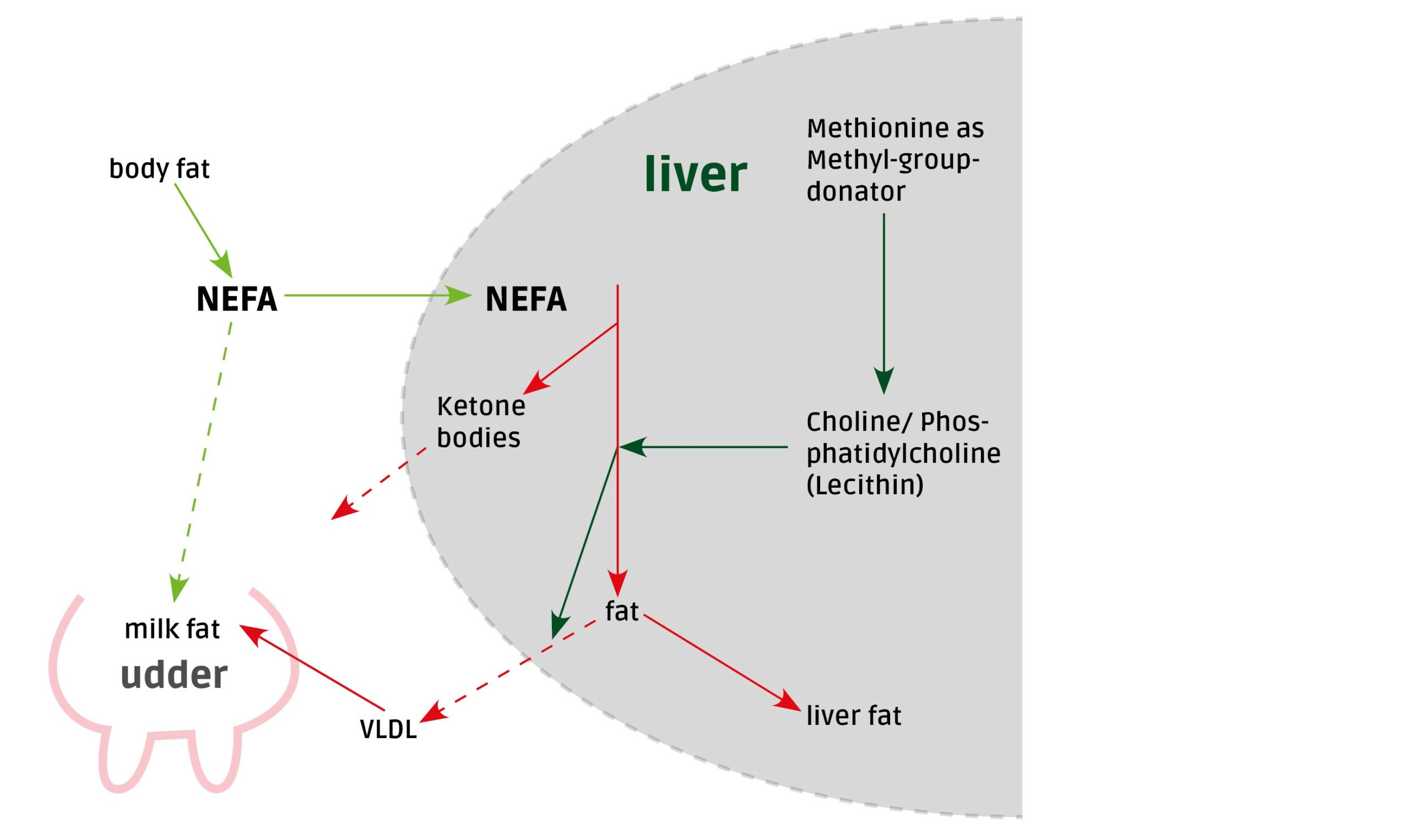Early lactation is the most important
period for the dairy cow
Early lactation is one of the critical phases within the lactation of a dairy cow. With reduced feed intake and at the same time increasing energy requirements, the cow falls into a negative energy balance. This energy deficit often starts before calving or in the transit phase. The dairy cow tries to compensate for this lack of energy by mobilising the body’s own energy depots, especially body fat (lipolysis). To a certain extent, this is a natural and physiological compensatory process found in all lactating mammals. When fat reserves are mobilised, free, non-esterified fatty acids (NEFA) are released into the blood.
Fat metabolism – central organ liver
In the case of rapid fat mobilisation, these NEFA accumulate to a high degree in the blood, as they cannot be completely used in the mammary gland as a precursor for milk fat synthesis or for energy balance. The liver plays a very important role in the conversion of fatty acids. In the liver, the free fatty acids are partly incorporated into triglycerides (fat) and excreted from the liver in the form of very low density lipoproteins (VLDL). The synthesis of VLDL in the liver is dependent on the supply of choline or phosphatidylcholine (also called lecithin). However, this process is limited in dairy cows. If there is not enough choline/phosphatidylcholine available, it can also be formed from methionine (Fig.1).

Fig.1: Scheme regarding the metabolism of non-esterified-fatty acids (NEFA) in the dairy cow (according to DRACKLEY 1999, modified)
Ketosis risk and fatty liver
Reduced feed intake and a clear lack of energy lead to a rapid accumulation of high amounts of free fatty acids (NEFA). Often the capacity of the liver to use the fatty acids for energy and to eliminate them through the formation of lipoproteins is exceeded. The excessive formation of ketone bodies (ketosis) and deposition of fats in the liver (liver fatty degeneration) often lead to ketotic secondary diseases and disorders of liver function. A certain accumulation of fat in the liver tissue during the first weeks of lactation is natural, but an excess impairs all metabolic processes in the liver and can result in irreversible damage to the liver tissue.
Without phosphatidylcholine (lecithin) no formation of lipoproteins
The lipoproteins that are important for milk fat synthesis are only formed in the liver if sufficient phosphatidylcholine (lecithin) is available. Choline is an important component of lecithin. Methionine, in addition to its role as an amino acid, can alternatively be used as an important methyl group donor for the formation of choline. A sufficient supply of available choline and methionine led in many studies to an improved metabolic state, a reduction in ketotic sequelae and improved milk yield. (Summary in Brüsemeister and Südekum, 2006) A comprehensive summary of the role of lecithin in the liver metabolism of the dairy cow can also be found in Pinotti et al, 2002.
BEWI-SPRAY® 99 L increases milk yield and ingredients in practical use
In contrast to pigs and chickens, choline or lecithin is almost completely degraded in the rumen of ruminants. BEWI-SPRAY® 99 L contains rapeseed lecithin and thus provides natural phosphatidylcholine in rumen-protected form. At the same time, the use of BEWI-SPRAY® 99 L in the feed provides rumen-protected fat and thus significantly improves the energy supply of the dairy cow and reduces the negative energy balance.
BEWI-SPRAY® 99 L provides natural phosphatidylcholine (lecithin) to support liver metabolism and prevents fatty liver!
Since the high demand for choline in the liver metabolism of the dairy cow is known, the possible supporting effect of BEWI-SPRAY® 99 L was tested on our dairy cattle partner farm.
Pure, rumen-protected fat was added to the maize-silage-emphasised TMR ration with a cereal-based energy supplement. After a corresponding control period, the fat powder BEWI-SPRAY® 99 M was then replaced by rumen-protected fat with rapeseed lecithin (BEWI-SPRAY® 99 L).

Conclusion: A supplementation of rumen-protected lecithin has several positive effects on the farm!
Obviously, the additional intake of rumen-protected lecithin under practical conditions in a high-performance herd led to an improved metabolic situation and an increase in milk yield and milk constituents.
Since this feeding test, the farm has continuously used the rumen-protected fat with rapeseed lecithin (BEWI-SPRAY® 99 L) to secure the energy supply and support the liver metabolism of its high-performance cows.